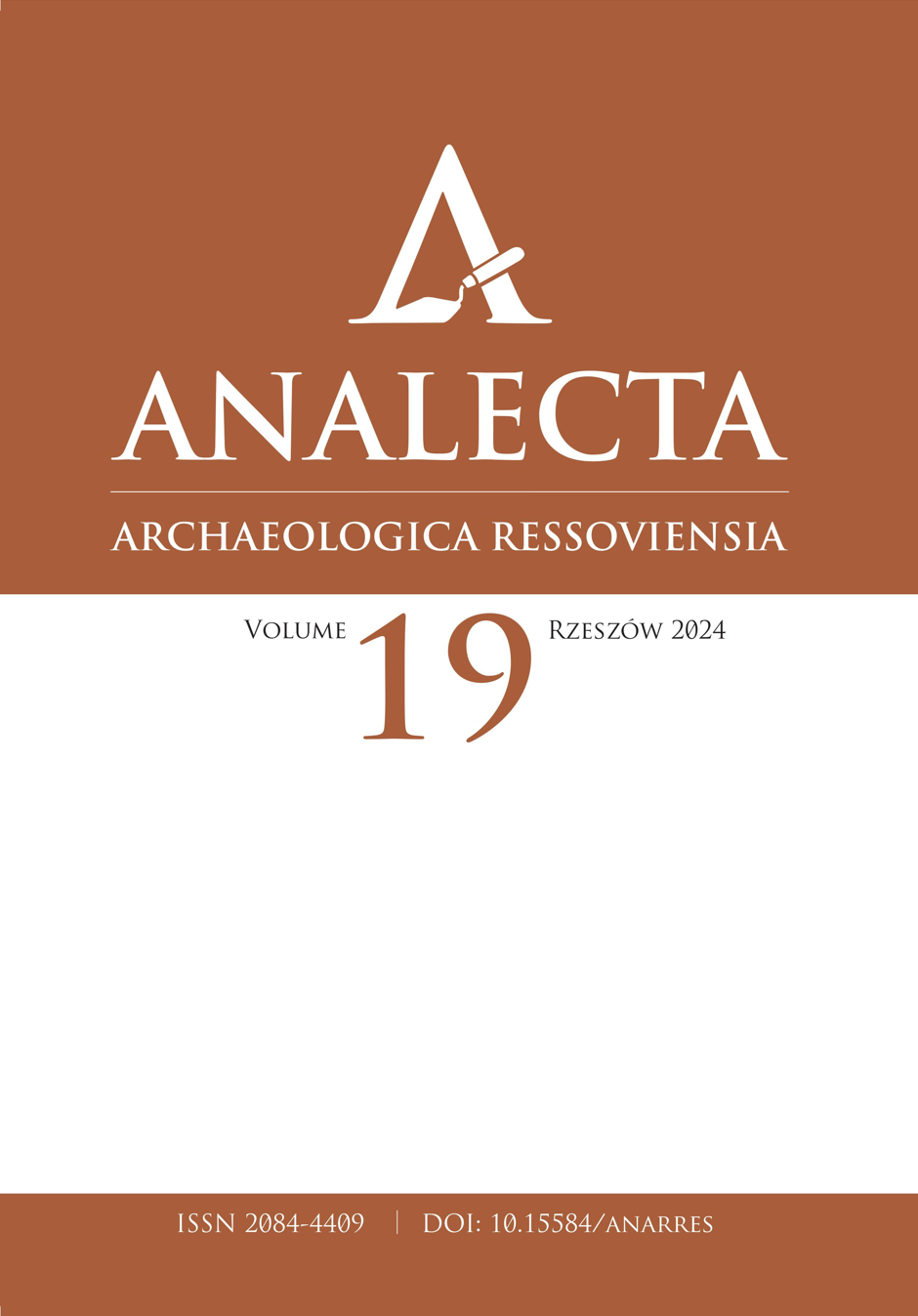Voiced or Silent? The Sound of the Sistrum in Ancient Egypt
DOI:
https://doi.org/10.15584/anarres.2024.19.1Słowa kluczowe:
Ancient Egyptian rattles, archaeological rattles, music in Ancient Egypt, Ancient Egyptian instruments, archaeoacoustics, archaeomusicologyAbstrakt
The sistrum was one of the most popular idiophones of Antiquity and, of all the musical instruments, it was most closely associated with the culture of Ancient Egypt, being present there for most of the time of this civilization’s existence. To this day, numerous examples in a diversity of shapes have remained and their representations also appear on the walls of temples and tombs. They also can be found in statuary sculptures as well as small plastic art. The sound of sistrum was an important element of the cult of varies deities, but primarily that of Hathor. The symbolic function was so strong that the instrument itself became a votive object. Some researchers believe that only the arched sistrum performed a sound purpose, while the faience naos-sistrum supposedly lacked this function. To obtain a more comprehensive picture of the sounds produced by the sistrum, and to evaluate the acoustic capabilities of the naos-sistrum, the experimental approach was employed.
Downloads
Bibliografia
Allen J. P. 2001. Middle Egyptian. An Introduction to the Language and Culture of Hieroglyphs. Cambridge: Cambridge University Press.
Baines J. and Málek J. 1995. Egipt (= Wielkie Kultury Świata), trans. T. Derda. Warszawa: Wydawnictwo Penta.
Both A. A. 2019. Archaeomusica – making the past audible. The Museum Journal 62(3), 425–437.
Czajka I. 2021. Odzyskać zamilkłe brzmienia: o numerycznej syntezie dźwięku grzechotek ceramicznych. In A. Gruszczyńska-Ziółkowska (ed.), Wydobyte z ciszy. Warszawa: Instytut Muzykologii Uniwersytetu Warszawskiego, Muzeum Uniwersytetu Warszawskiego, Fundacja Varia, 129–144.
Drobner M. 1973. Akustyka muzyczna. Kraków: Polskie Wydawnictwo Muzyczne.
Fischer H. G. 1962. The Cult and Nome of the Goddess Bat. Journal of the American Research Center in Egypt 1, 7–18.
Gruszczyńska-Ziółkowska A. and Tatoń K. 2021. Tajemnice dźwięku „pisanki”. In A. Gruszczyńska-Ziółkowska (ed.), Wydobyte z ciszy. Warszawa: Instytut Muzykologii Uniwersytetu Warszawskiego, Muzeum Uniwersytetu Warszawskiego, Fundacja Varia, 95–128.
Hickmann H. 1962. Musikgeschichte in Bildern, 2: Musik des Altertums, 1: Aegypten. Leipzig: VEB Deutscher Verlag für Musik.
Köpp-Junk H. 2020. The Sound of Ancient Egypt – Acoustics and Volume Measurements. ARS INTER CULTURAS 9, 13–33. DOI: 10.34858/AIC.9.2020.327
Manniche L. 1991. Music and Musicians in Ancient Egypt. London: British Museum Press.
Manniche L. 2010. The cultic significance of the sistrum in the Amarna period. In A. Woods, A. McFarlane and S. Binder (eds.), The Egyptian Culture and Society. Studies in honour of Naguib Kanawati, 2. Le Caire: Publications du Conseil Suprême des Antiquités de l Égypte, 13–26.
MIMO Consortium = Revision of the Hornbostel-Sachs Classification of Musical Instruments by the MIMO Consortium, 08.07.2011 (http://www.mimo-international.com/documents/hornbostel%20sachs.pdf, access: 10.07.2023).
Pawlicki F. 1974. Egipskie sistra. Rocznik Muzeum Narodowego w Warszawie 18, 7–21.
Quiñoes de Leon M. S. M. 2015–2016. El Sistro: el sonido de Egypto en Creta. ISIMU 18–19: De Egipto y otras tierras lejanas. Covadonga Sevilla Cueva in memoriam, 201–216. DOI: 10.15366/isimu2015-2016.18-19
Reynders M. 1998. Sšš.t and shm: Names and Types of the Egyptian Sistrum. In W. Clarysse, A. Schoors and H. Willems (eds.), Egyptian religion. The last thousand years. Studies dedicated to the memory of Jan Quaegebeur, 2 (= Orientalia Lovaniensia Analecta 85). Leuven: Peeters Publishers, 1013–1026.
Sachs C. 1921. Die Musikinstrumente des Alten Agyptens. Berlin: K. Curtius.
Sachs C. 1940. The History of Musical Instruments. New York: W.W. Norton & Company Inc.
Saura-Ziegelmeyer A. 2015. Agiter le sistre pour la déesse: reconstituer la production sonore d’un idiophone. Sons et audition dans l’Antiquité 98/2015, 215–235. DOI: 10.4000/pallas.2753
Schneider T. 2006. Leksykon Faraonów, trans. R. Darda. Warszawa: Wydawnictwo Naukowe PWN.
Spencer B. 2003. Dance in the Ancient Egypt. Near Eastern Archaeology 66(3), 111–121.
Suddreth R. J. 2019. A Study of the Loop Sistrum (Accession Number: 1994.4.26) at the University of Memphis, manuscript of the thesis in the archive of the University of Memphis, Electronic Theses and Dissertations. 1977 (https://digitalcommons.memphis.edu/etd/1977, access: 10.07.2024).
Tatoń K. 2013. Archeologia Muzyki. Starożytny Egipt. Bielsko- Biała: Antenor.
Tatoń K. 2021. Grzechotki archeologiczne porządkowane dźwiękiem. In A. Gruszczyńska-Ziółkowska (ed.), Wydobyte z ciszy. Warszawa: Instytut Muzykologii Uniwersytetu Warszawskiego, Muzeum Uniwersytetu Warszawskiego, Fundacja Varia, 61–94.
Tatoń K. and Czajka I. 2021. The Rattles from Tell El-Farcha. Acoustic Research with the Use of Numerical Sound Reconstruction. Studies In Ancient Art And Civilization 25, 7–30.
Teeter E. 2009. Inside the Temple. The Role and Function of Temple Singers. In E. Teeter and J. H. Johnson (eds.), The Life of Meresamun. A Temple Singer in Ancient Egypt. Chicago: The Oriental Institute of the University of Chicago, 25–29.
Tsakalidou A. 2021. Music and Egyptian cult: another aspect to communicate with the gods, manuscript of the postgraduate thesis in the archive of the University of the Aegean, Department of Mediterranean Studies, Rhodes (https://hellanicus.lib.aegean.gr/handle/11610/22726, access: 29.07.2024).
Wilkinson R. H. 2005. The Complete Gods and Goddesses of Ancient Egypt. Cairo: The American University in Cairo Press.
Yehia E. F. and Abdelhakim W. M. 2021. Solo Singing Etiquette for Women in Ancient and Modern Egypt. Athens Journal of History 7, 41–70.
Ziegler C. 1984. Sistrum. In W. Helck and E. Otto (eds.), Lexikon der Ägyptologie, 5: Pyramidenbau Steingefässe. Wiesbaden: Harrassowitz Verlag, 959–963.
www.metmuseum.org, access: 29.07.2024
www.britishmuseum.org, access: 29.07.2024
Pobrania
Opublikowane
Jak cytować
Numer
Dział
Licencja
Prawa autorskie (c) 2024 Analecta Archaeologica Ressoviensia

Utwór dostępny jest na licencji Creative Commons Uznanie autorstwa – Na tych samych warunkach 4.0 Miedzynarodowe.

